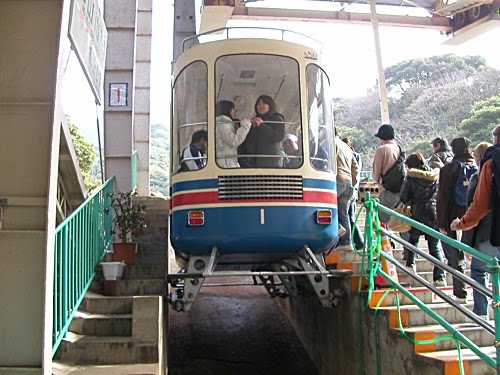Japan has a number of Daibutsu (大仏) in various places. One of the oldest is the Nihon-ji Daibutsu in Chiba Prefecture, across Uraga Channel (at the mouth of Tokyo Bay) from Yokosuka. Those of us who come from Puget Sound Naval Shipyard refer to it as "The Stone Buddha".
To get there from Tokyo (or Yokosuka) you can take the train to Kurihama. Either the Keikyu Line or the JR Line will do. From there you can catch the bus to the ferry terminal or walk. If you choose to walk, follow the canal to the sea and then turn right. You will find the ferry terminal, you can't miss it.
On the way you will pass by the the Monument in Commemoration of the Landing of Commodore Perry, who landed there at Kurihama Kaigan (Kurihama Beach) on July 8th, 1853.
From the ferry I believe that there are two ways to get to the Daibutsu, but I only know one if them. After crossing Uraga Channel on the ferry from Kurihama in Yokosuka, you arrive in Kanaya in Chiba Prefecture. After a short walk, you catch the gondola that will take you up most of the way to the top of Mt. Nokogiri (Sawtooth Mountain) where you begin the hike to the Daibutsu.
At the top of the ride is a booth where people can buy a fortune on a slip of paper and then tie it to a tree on the path there. I believe this to be a fertility thing for couples - note the large black penis in the booth. It seems that the Japanese do not have quite the same hang-ups about sex that we Americans do (that is not to say that they are immodest).
Walking the paths there are a number of things to see. There are four items of major historical interest. The first is the Kenkon-Zan Nihon-ji, the Nihon Temple on Mt. Nokogiri. It was founded approximately 1300 years ago by Imperial order of Emperor Shōmu and Empress Kōmyō back in the days when the Emperor really had political power and ran the country. A handout that you get when you enter the grounds points out that the Emperor gave the Temple an Imperial tablet inscribed by his own hand and about 18½ tons of gold. the Empress gave a scroll that she embroidered by her own hand with 33 images of the Buddha Kwan-yin and ten bolts of damask and brocade.
There are also the 1500 stone figures of Tokai Arhats carved between 1779 and 1798.
Many of these had the heads knocked off during an anti-Buddhist revolt during the Meiji era and are only now being repaired. It is said that no two of them have the same face and that everyone could have found the one that has his own face before they were damaged. Now your face may be on one of the ones that had the head knocked off.
Another amazing site is the Kannon Bosatsu aka the Hyaku Shaku Kannon. This was carved during the later 20th century. It is in a large chamber that is so acoustically perfect that if you stand at the feet of the Kannon and speak in a normal tone of voice, or even a loud whisper, you can be easily heard through the whole area. How I would love to play a string quartet recital there!
The 大仏 is in an open park like area and dominates magnificently.
This is one of the largest Buddhas in Japan and the world and I think that it was once the largest Buddha in Japan. It is in any case the largest stone carved Buddha in Japan being 31.05 meters (101.9 feet) high. It is magnificent.
The surrounding park is a lovely place to picnic or just rest and watch the hawks and other birds while enjoying the Buddha and some other notable sights which I will leave you to discover.
じゃあね
Thursday, April 22, 2010
Subscribe to:
Post Comments (Atom)












No comments:
Post a Comment